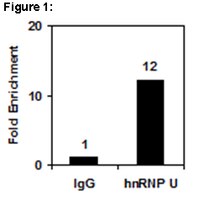03-206 Sigma-AldrichRIPAb+™ hnRNP U - RIP Validated Antibody and Primer Set
This RIPAb+ hnRNP U -RIP Validated Antibody & Primer Set conveniently includes the hnRNP U antibody & the specific control PCR primers.
More>> This RIPAb+ hnRNP U -RIP Validated Antibody & Primer Set conveniently includes the hnRNP U antibody & the specific control PCR primers. Less<<Recommended Products
Overview
| Replacement Information |
|---|
Key Specifications Table
| Species Reactivity | Key Applications |
|---|---|
| H | RIP, WB |
| References |
|---|
| Product Information | |
|---|---|
| Format | Purified |
| Control |
|
| Presentation | Anti-hnRNP U (Mouse Monoclonal), Part # CS207320. One vial containing 50 µg of protein G purified mouse IgG1 in 0.1M Tris-glycine, pH 7.4, 0.15M NaCl, 0.05% sodium azide and 30% glycerol. Store at -20°C. Normal Mouse IgG, Part # CS200621. One vial containing 125 µg of purified mouse IgG in 125 µL of storage buffer containing 0.1% sodium azide. Store at -20°C. RIP Primers, Ribosomal Protein S19, Part # CS207321. One vial containing 75 μL of 5 μM of each primer specific for human c-myc 3' UTR. Store at -20°C. FOR: ACG CGA GCT GCT TCC ACA G REV: AGC TGC CAC CTG TCC GGC |
| Quality Level | MQ100 |
| Physicochemical Information |
|---|
| Dimensions |
|---|
| Materials Information |
|---|
| Toxicological Information |
|---|
| Safety Information according to GHS |
|---|
| Safety Information |
|---|
| Packaging Information | |
|---|---|
| Material Size | 10 assays |
| Material Package | 10 assays per set. Recommended use: ~5 μg of antibody per RIP (dependent upon biological context). |
| Transport Information |
|---|
| Supplemental Information |
|---|
| Specifications |
|---|
| Global Trade Item Number | |
|---|---|
| Catalog Number | GTIN |
| 03-206 | 04053252556128 |
Documentation
RIPAb+™ hnRNP U - RIP Validated Antibody and Primer Set SDS
| Title |
|---|
RIPAb+™ hnRNP U - RIP Validated Antibody and Primer Set Certificates of Analysis
| Title | Lot Number |
|---|---|
| RIPAb+ hnRNP U - NRG1880400 | NRG1880400 |
| RIPAb+ hnRNP U - 3446864 | 3446864 |
| RIPAb+ hnRNP U -2512131 | 2512131 |
| RIPAb+ hnRNP U -2612284 | 2612284 |
| RIPAb+ hnRNP U -2695268 | 2695268 |
| RIPAb+ hnRNP U -2726411 | 2726411 |
| RIPAb+ hnRNP U Monoclonal Antibody/Primer Set | 3133122 |










